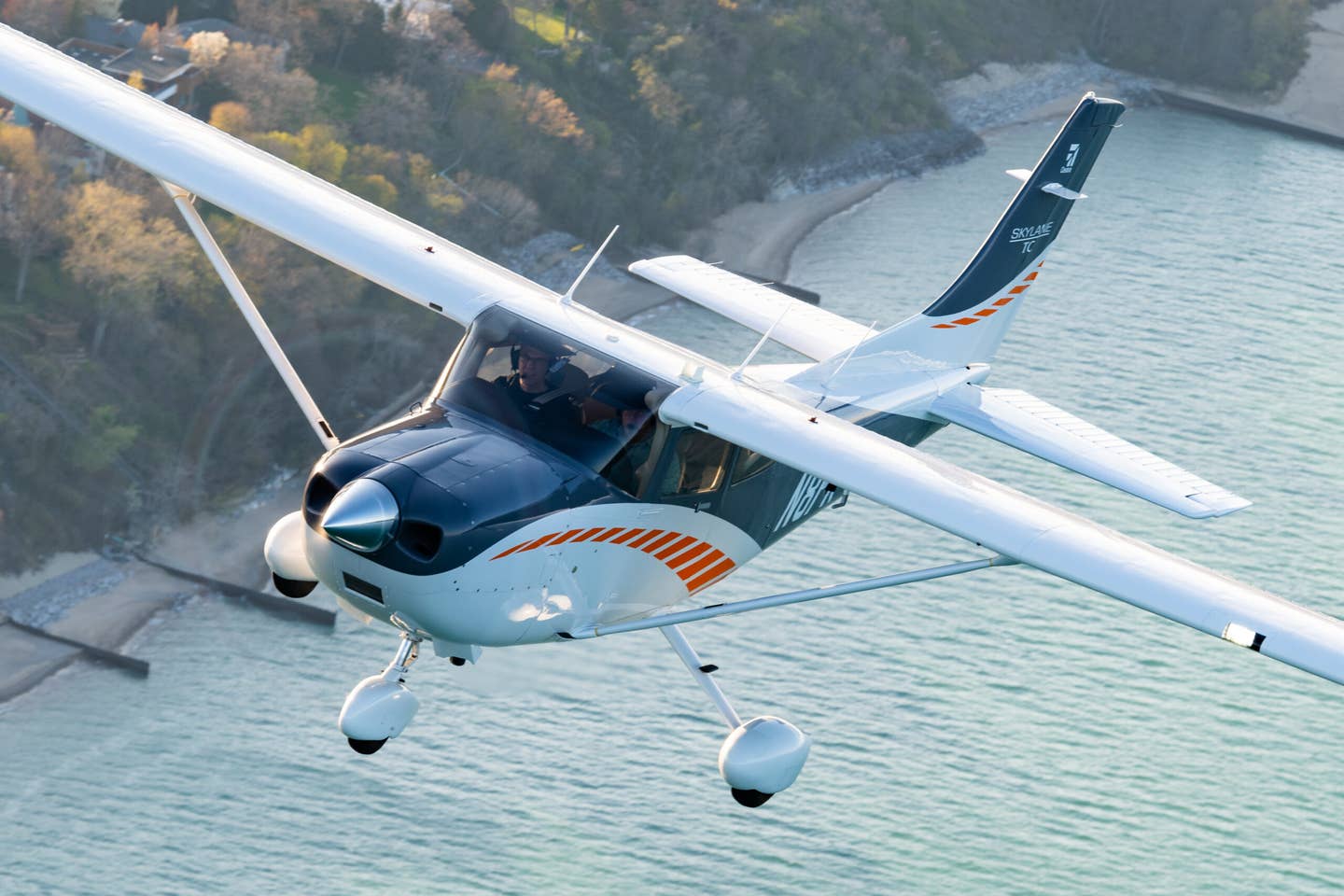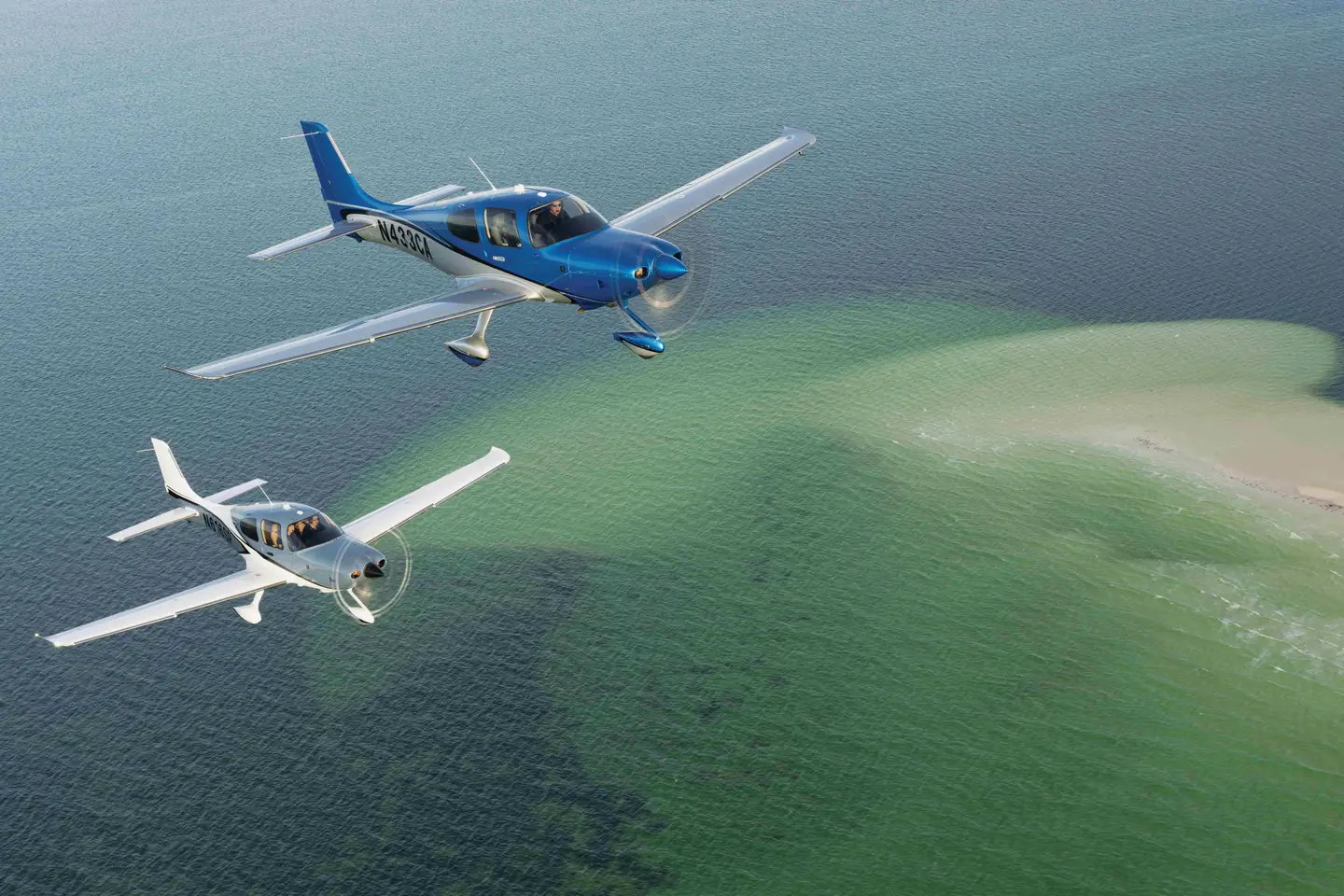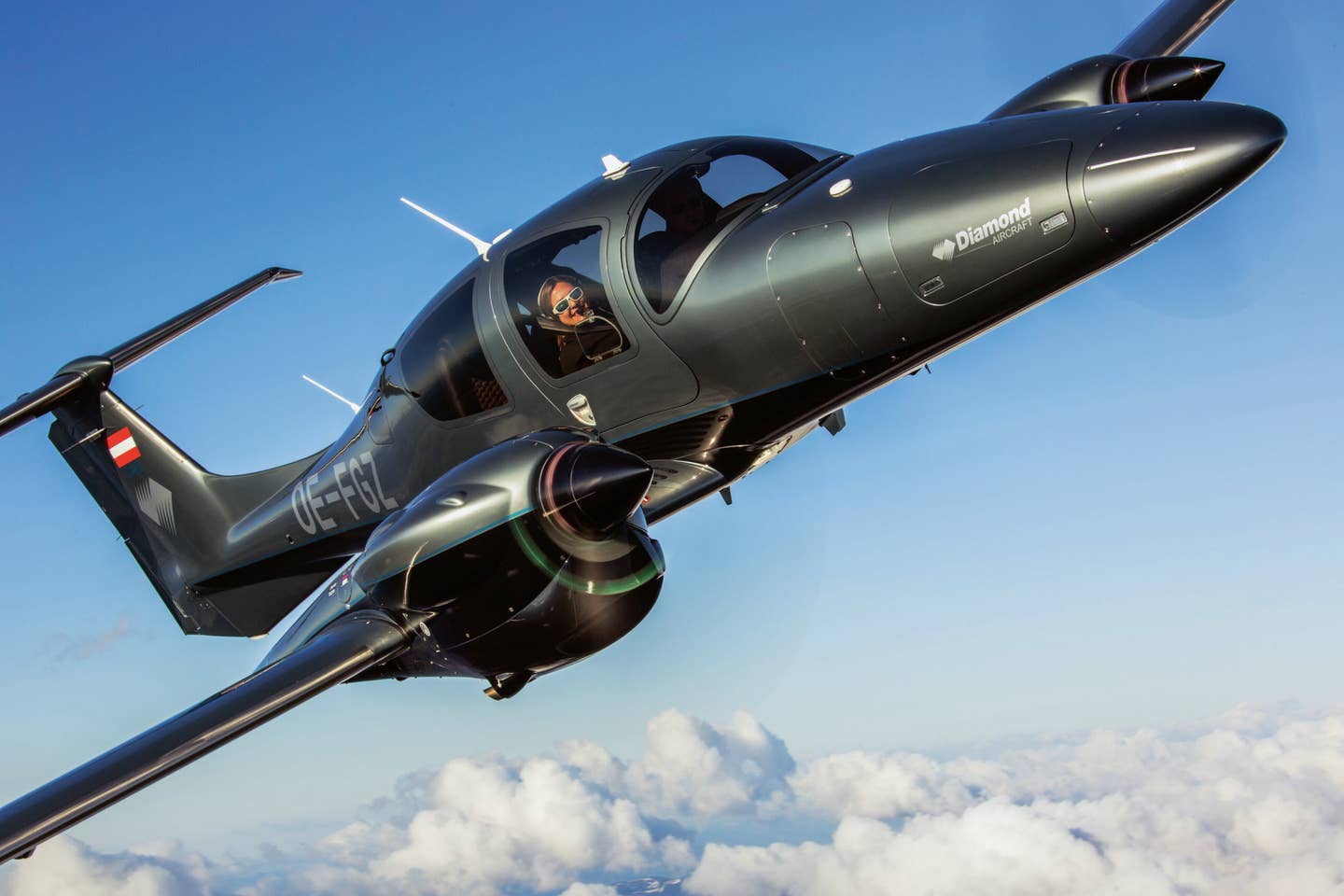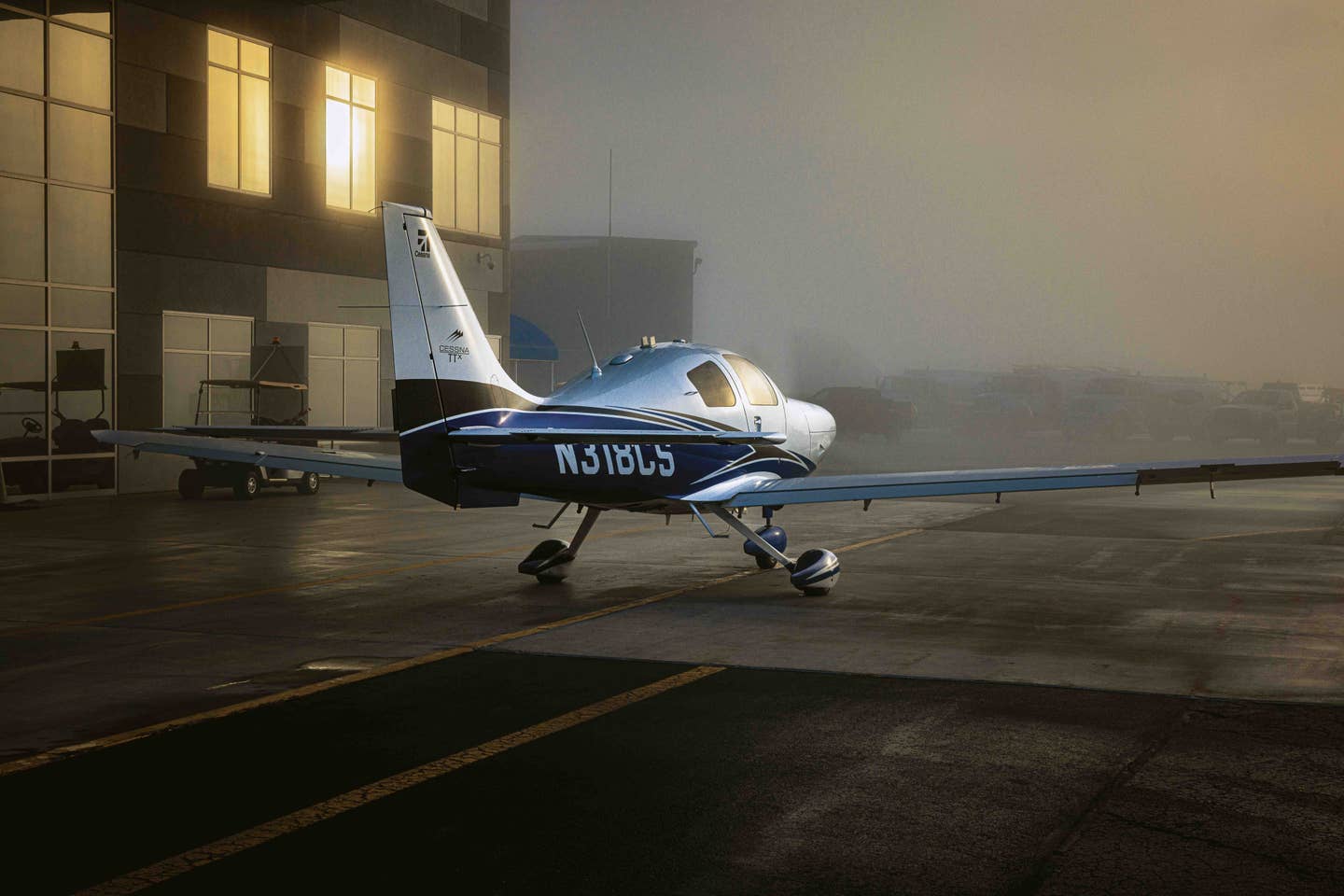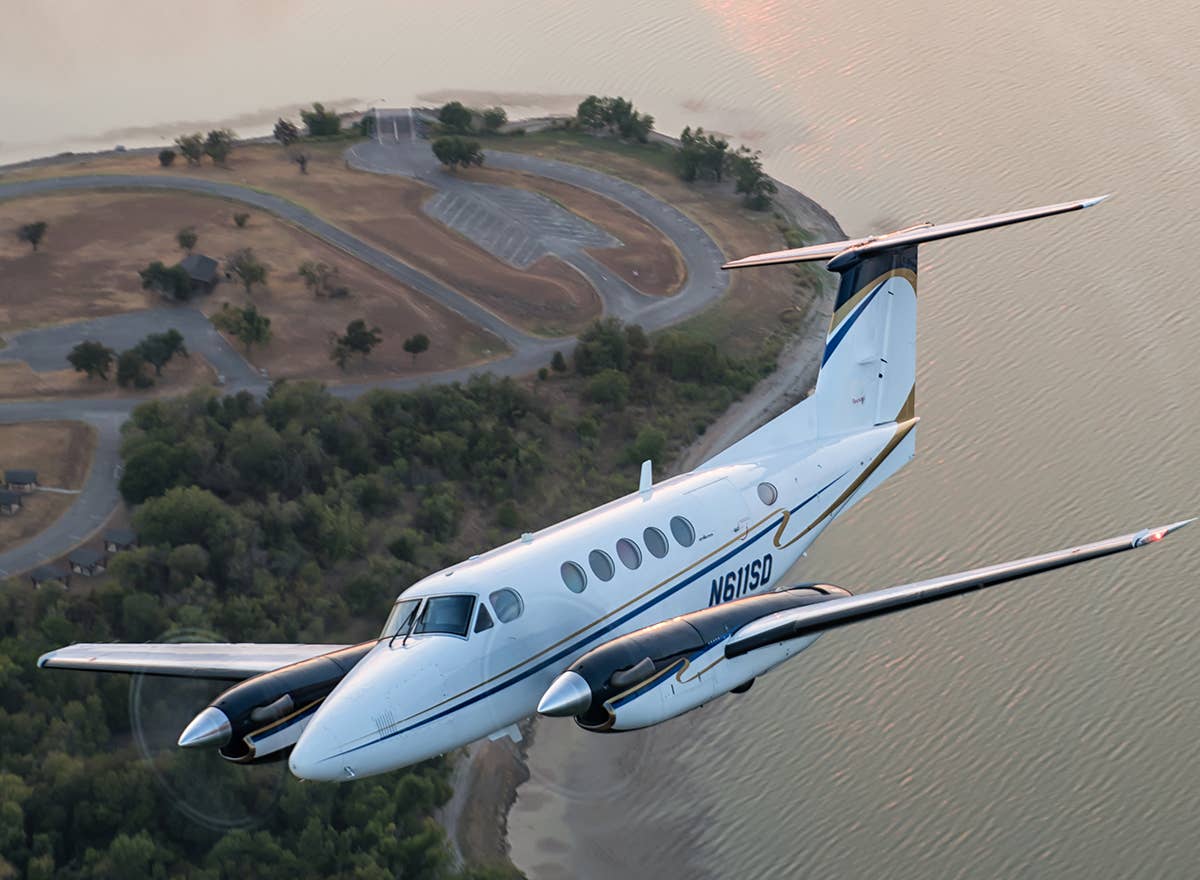
A legacy agricultural aircraft manufacturer turns to firefighting. [Courtesy: Gary Blockley]
My first close-up experience with the effectiveness of aerial firefighting happened during the devastating Woolsey Fire in Southern California in 2018. About 1,500 homes and other structures in my neighborhood and the surrounding area were destroyed by flames in a few days. The fire started on a Thursday afternoon, and by the time the sun set that Friday, 70,000 acres were scorched. Two related problems can be blamed for the devastation: The strong winds spread the fires with immense speed; they also prevented the use of aerial support.
The flames of the Woolsey Fire flared up in the area of Simi Valley and sped all the way down to the beaches of Point Dume and Malibu — a distance as an airplane flies of about 20 miles. I’m sure the last thing the owners of the multimillion-dollar homes along the beaches expected was for their houses to burn as a result of a wildfire.
The cloud of smoke and debris above the Santa Monica mountains on Friday morning looked like a massive Florida thunderstorm. Being evacuated from my home, I watched from the streets of San Fernando Valley as the brave firefighters from CalFire pointed their airplanes and helicopters toward the hills to attack the flames from the air. Drop by drop, they worked to minimize the devastation and make the work for the ground teams easier.
Organized firefighting efforts have existed since the days of ancient Rome, but aerial firefighting is, naturally, a more recent phenomenon.
Like most new endeavors, aerial firefighting had modest beginnings. According to the U.S. Centennial of Flight Commission, water or fire retardant would be dumped out of beer kegs or sprayed with common garden hoses carried in single-engine piston airplanes. In the early 1950s, military biplanes were modified to serve as air tankers.
Today, many firefighting aircraft are helicopters and older twin-engine airplanes that are expensive to operate and maintain and, in some cases, have long turnaround times. During the Woolsey Fire, I saw massive DC-10 air tankers, which can release an astounding 12,000 gallons in only eight seconds; smaller twin-turbine North American-Rockwell OV-10As; and Erickson Aircranes—helicopters that look like huge, otherworldly creatures sucking up water from nearby lakes and waterways to drop on the fire.
With only one engine to maintain and feed, and the ability to land on shorter strips, Single-Engine Air Tankers (SEAT) can serve a great purpose for aerial firefighting. The Antonov A-2 was an early SEAT option, first used as such in the 1950s.
In the early 1990s, Air Tractor introduced the AT-802, an agricultural airplane with an 800-gallon hopper that was also turned into a firefighting version.
Air Tractor happens to be intimately related to Albany, Georgia-based Thrush Aircraft, which certified its SEAT airplane — the 510G Switchback — in October of 2018. The 510G has a 510-gallon hopper capacity and an 800 shp GE H80 engine. Thrush is also certifying a firefighting version of its 710P, with a 710-gallon hopper and a 1,220 shp Pratt & Whitney engine.
What truly sets the Switchback apart from other firefighting aircraft is its ability to quickly switch to agricultural spraying operations. The fire gate is removed and the ag gate installed, a process that takes just a few minutes. The airplane is available with one or two seats, allowing another person to fly along for training or observation purposes.
Thrush offers an in-house training program that combines ground school, simulator and in-aircraft instruction to help pilots who might not possess much of the necessary and unusual combination of experience — tailwheel and turbine — learn to successfully fly the Thrush.
At the typical takeoff weight of 10,500 pounds, a highly skilled pilot can take off in about 1,500 feet in a 510G. Once the load is dropped and the airplane is lighter, the landing distance can be as short as 350 feet using the beta thrust. This allows firefighters to drop in on grass strips near the site of a wildfire.
Thrush Aircraft was founded in 2003 when Payne Hughes bought the then-defunct Ayres Corporation.
The company has roots in Snow Aeronautics, which was founded in the 1950s by legendary ag aircraft designer, Leland Snow.
“Leland Snow was the godfather of our industry,” said Eric Rojek, vice president of sales at Thrush. “He birthed the agricultural aircraft and then Rockwell purchased his company from him. Leland left and started Air Tractor.” And there lies the connection. But despite being competitors, the companies work together. “At Oshkosh we’re both in the NAAA [National Agricultural Aviation Association] booth promoting the industry,” Rojek said.
The name Thrush had nothing to do with someone contracting an oral infection. Rojek said Rockwell had a history of naming airplanes after birds. The Thrush is a pretty, cinnamon-brown songbird with a spotted chest, native to the region. The airplane factory has been at Albany’s Southwest Georgia Regional Airport (KALB) since 1965.
Rojek said two things have significantly changed the ag industry in the past 30 years. The first is the domination of turbine-powered engines, which resulted in increased reliability and bigger hopper capacities. The second is GPS for application flow control, which produced many benefits: the ability to automatically turn the flow on and off at precise boundaries; have variable rate applications; and very precise invoicing with dates, times, and application rates. The GPS system will even adjust the flow as the ground speed changes on upwind and downwind passes over a field to maintain an even application. “So now the pilot can concentrate more on just flying the airplane,” said Terry Humphrey, who heads up flight tests and pilot training.
Standard on every Thrush is the MVP-50T electronic engine monitor from Electronics International with about 50 different functions, including an active G-meter, onboard data recording and many ag-specific features. Precision agricultural application is enabled by a Differential GPS navigation system.
“It’s a very accurate GPS system,” Humphrey said. “Basically, you’re just shooting one extremely precise localizer approach after another.” The desired spray path is entered into the system. At the top of the instrument panel is a light bar with dots that tell you when you are on the center line of the intended path. Several DGPS systems are available for the Thrush.
Fire operations also use an electronic system that allows the operator to program a full-salvo dump, 510 gallons in two seconds, a lengthened release, or multiple partial releases of the material in the hopper.
The Thrush also can be flown with night-vision goggles, which allows agricultural operators to spray at night when winds are calm and the fields are free of workers and full of bugs. An infrared system is also available to enhance forward visibility in poor conditions, such as smoky areas during firefighting operations. “It’s a simple little ag airplane but the technology is really cool. The industry is healthy, so everyone is investing more and more in using new technologies to do a better job,” Rojek said.
Because the 510G has the ability to quickly switch from an agricultural to a firefighting airplane, Thrush is starting a program called Ag SEATs. A firefighting pilot needs what is referred to as a SEAT card issued by the U.S. Department of the Interior’s Office of Aviation Services. So, Thrush is setting out to encourage ag pilots to go through the required accreditation. That way, ag pilots can use their Switchbacks for community firefighting operations.
Conversely, Switchbacks that are dedicated for fire ops can be used for other purposes. “Georgia Forestry, for example, while their main mission is fire, now they can fertilize and seed, and if there is any type of breakout they can apply fungicide,” Rojek said. “So, the ag-guys can do fire and the fire guys can do other work, also.” This allows the airplanes to generate revenue in other types of applications rather than being idle during the off season.
The biggest difference for a pilot flying ag versus fire is communication. In the Switchback, there are several radios that allow the pilot to communicate with ATC, ground crew, the local sheriff, the fire boss, etc. During agricultural spraying, however, there is rarely a need to communicate with anyone.
Whether used for ag or fire, the rough environment requires that the airplanes be built tough. The Switchback has an all-metal roll cage and a main spar that the FAA has approved for a 60,000-hour life limit. The spar is the only life-limited component in the airplane. All other parts are replaced on condition.
Inside the factory, Rojek pointed out various processes that make the metal pieces stronger and more corrosion resistant. It would be hard to bend this airplane if you tried. “The cool thing about Thrush is we take the raw material in one door, load it, fabricate it and do pretty much the entire Thrush manufacturing process all in house,” he said.
One big testament to the design and manufacturing processes is the complete lack of Airworthiness Directives against any Thrush airplanes built after 2003. As any airplane owner knows, the lack of ADs means less maintenance, less downtime and lower costs.
With the low-level flying demanded by agricultural and firefighting operations, power lines and other cables can get in the way. Thrush incorporates a wire-strike protection system, with wire cutting blades on the main landing gear legs, wire cutters and deflectors in front of the cockpit, and a wire deflector cable from the cockpit to the vertical fin. The environment also exposes the valuable turbine engine to dust and smoke.
A K&N filter, first used for off-road racing, is installed in the air intake and Rojek said it is 99 percent efficient for FOD prevention.
Thrush focused its design on ease of maintenance, so many inspection panels can be removed quickly with camlocs. There are 37 removable panels on the wings alone to ease inspections.
The 510G is equipped with an MVP-50T engine-monitoring system, which includes about 50 functions, some of which are specific to agricultural operations.
Several different systems can be installed for firefighting purposes.
While many airplanes leave the factory with electronic quantity indicators, lines on the composite walls of the hopper also help the pilot know how much is left.
The stick is linked to the ailerons through pushrods, helping create terrific maneuverability.
Several DGPS options are available that help agricultural and firefighting pilots make highly accurate applications.
On the outside, the Thrush might appear to be a basic airplane. But there is a lot of advanced technology inside, prompting the need for a large circuit-breaker panel.
Being a turbine-powered taildragger, the Thrush requires the pilot to have strong stick and rudder skills.
What does it take to be an AG/firefighting pilot?
Fighting fires in a Single Engine Air Tanker is one of the coolest jobs a pilot can have. You fly fast at a low level, drop stuff out of the airplane and get the satisfaction of doing something that can help other people and/or the environment. But SEAT firefighting requires a somewhat odd combination of piloting experience: tailwheel and turbine.
Aspiring aerial firefighters in Georgia have a path to get there. The Georgia Forestry Commission requires at least a Commercial Pilot Certificate, an Instrument rating and 500 hours. Pilots must fly wildfire patrol in a Cessna 182 for at least one year and become certified wildland firefighters before moving on to actual firefighting. The pilots also do a lot of tailwheel training in a Decathlon before moving into the Thrush. “We try to get them signed off and get at least 150 hours of tailwheel before they can even start flying the Switchback, because it can be a handful when heavily loaded,” said Clay Chatham, GFC air operations supervisor.
In order to fly firefighting operations in the Thrush, pilots must have accumulated 1,500 hours of total flight time and take factory training and turbine-transition training. GFC bought two two-seat airplanes to train their own pilots. The Thrush training program is followed by an additional 50 hours of dual flight instruction by an in-house instructor and a check ride before they are considered "mission ready," Chatham said. The pilots also have to attend a course at the National Aerial Firefighting Academy, though there is no "carding" requirement for Georgia's pilots as there is for federal firefighting pilots. Each state has its own requirements, but several regulations apply to all firefighting pilots, including strict dress codes, duty times and communications rules.
Chatham said he employs 25 part-time pilots for patrol missions only. Often they build some flight time and move on to the airlines. But the full-time pilots stay. “Once they get on, they don’t leave,” he said. While the pay is nothing to write home about, with a full-time starting salary of $36,000 and average salary after several years in the high 40s, the work-life balance is simply too good. “It’s good old-fashioned flying,” Chatham said. “You’re on your own, VFR, and we don’t fly after dark, so we can have a good family life. You have a lot of discretion to go out and do what needs to be done, so you’re not micromanaged at all, and you’re doing something good for the state. It is a service job just like the police and structural firefighting, which we are very proud to be a part of.”
Playing with Fire
Wildfires were far from my mind as I entered the Thrush campus at KALB on a bone-chilling, gray day in January. But inside, the atmosphere was warm with the Georgia Forestry Commission’s firefighting team gathered in the training facility. While counter intuitive, winter is Georgia’s fire season because this is when the brush dies and burns. There were no fires to fight the day I was there, but the pilots and ground-support crew were in training mode.
GFC uses a mobile fueling station, which was parked outside the Thrush factory along with two two-seat Switchbacks. Clay Chatham, GFC's air operations supervisor, said they also use a Decathlon for tailwheel training along with a Bell 407 helicopter for water drops and 16 182s for patrol, which is the organization’s primary mission. Nine full-time pilots support the entire state of Georgia. They patrol every day there is potential for fire. The team’s headquarters are in Macon, Georgia, but it has seven hangars around the state. “In theory we’ve placed them strategically so we have less than an hour’s response to any location in the state,” Chatham said. “We find the fires early and get them out quickly.”
He said the lower acquisition and operating cost of the Thrush versus the Air Tractor were big sellers as his budget required an economical airplane. “The maintenance cycles are really good on the Thrush,” Chatham said. “And we have really good support from the company.” The price of a Switchback is just beyond $1 million. The higher-capacity Air Tractor costs about twice as much.
The primary mission for GFC is wildfire patrol. The Bell 407 was the only aircraft it used for suppression and the helicopter is a vital tool. The Switchback SEATs are economical additions to the fleet. “The Thrush is a lot more economical to operate.” Having had the Thrushes for less than a year, Chatham hasn’t had a chance to calculate numbers; but he expects the cost of operation for the Thrush to be about half that of the Bell.
I had a chance to hop in the Bell and see how it scooped up water from a small pond at the airport. The pilot observes the Bambi bucket through a small rear-view mirror mounted below the rudder pedals under the clear floor. The bucket filled up in seconds and we flew over to a spot that acted as a pretend fire to drop the load. The turnaround was extremely fast, but this type of firefighting requires a nearby water source.
While not quite as efficient, the Switchback’s 510-gallon hopper can be refilled in just a few minutes with the mobile ground station that the GFC team built. A 3-inch wide port on the Switchback’s fuselage makes this possible, and the pilot can leave the engine running during the reloading process. With many ag strips around Georgia that pilots fly Thrushes into, Chatham’s team can park its ground station near potential fires or get support from local fire departments.
The hopper can carry either dry applications (seeding or fertilizer for agricultural operations) or liquid (plain water or a powder mixture). The upper sides of the hopper have see-through composite panels with lines that indicate how much material is inside. A similar small panel is visible under the instrument panel and there is a digital readout too. There is no mistaking the quantity inside.
If you haven’t figured it out already, the 510-gallon capacity gave rise to the numerical name. The G comes from the engine — a 800 shp GE H80 spinning a four-blade, reversible, 102-inch Hartzell propeller. The fuel burn is about 50 gph during fire work, Chatham said, so the 228-gallon fuel capacity allows for four hours of solid work. However, a trained crew can fuel and fill the airplane with the engine running. “Literally they can crank it up and not turn it off until the end of the day,” Rojek said.
Before I sat in a firefighting airplane I had the impression that the release of the load would be a violent affair. After all, the airplane relieves itself of more than 4,000 pounds of weight in a matter of seconds. But riding along in the back of the Switchback as Chatham dropped a load over the imaginary fire, the process felt completely smooth.
To get a feel for how the Switchback flies, I jumped into Thrush’s Redbird simulator, which Rojek claims is the first sim to be configured for agricultural operations. We started with a little bit of familiarization, then moved on to stall-spin awareness.
In the simulator, I got the stall indication at around 60 mph, an impressive number for an airplane that can carry such a heavy load. I had a chance to take off with a light load followed by a heavy load. While I have theoretically seen the effect of weight changes before, I had not experienced the extremes of a change of thousands of pounds in a matter of minutes. The comparative sluggishness of the controls and increased takeoff distance with max gross weight was striking. The airplane can take off with 10,500 pounds, giving it a remarkable useful load of 5,700 pounds.
While flying a pretend agricultural sweep over a field in the Redbird, I was suddenly surprised when Humphrey gave me a catastrophic engine failure. There was no time to react before I was on the ground — a stark demonstration of the extraordinary skills required by a successful ag pilot. The Redbird training will help Thrush pilots be prepared when something catastrophic happens, such as an engine failure, loss of aileron control or flight into IFR conditions. (The Switchback is VFR only).
During Thrush’s training program, “the goal for the day in the sim is to scare you,” Rojek said.
Thrush 510G Switchback: By the Numbers
| Base price | $1,045,000 | Engine | GE H80 |
| Horsepower | 800 shp | Propeller | Hartzell, 4-blade |
| Seats | 1 or 2 | Length | 33 ft. 11 in. |
| Height | 9 ft. 6 in. | Wing area | 365 sq. ft. |
| Wingspan | 47 ft. 6 in. | Power loading | 13.1 lb./hp |
| Typical Operating Weight | 10,500 lb. | Empty weight | 4,800 lb. |
| Payload | 5,700 lb. | Hopper Capacity | 66 cu. ft/510 gal. |
| Max Usable Fuel | 228 gal./1,528 lb. | Max Operating Altitude | 12,000 ft. |
| Max Rate of Climb | 1,400 fpm | Never Exceed Speed | 163 kts |
| Max Cruise Speed | 43 ktas | Normal Operating Speed | 130 ktas |
| Stall Speed, Flaps Up | 82 kias | Stall Speed, Full Flaps | 76 kIas |
| Takeoff Distance Over 50 ft. | 2,150 ft. | Landing Distance Over 50 ft. | 2,050 ft. |
| Engine TBO | 4,000 hrs. | Max Range | 695 nm |
Flying the Thrush
Ag has a double meaning when it comes to the Thrush. Not only is it made for agricultural work — the pilot needs agility in order to fly it. Checking the oil requires some climbing moves to get to the oil door in front of the hopper. There is a footstep on the left side of the nose to stand on. Humphrey also showed me how to tiptoe onto the edge of the window before stepping down into the pilot’s seat.
With the large windows surrounding the cockpit, the visibility in the 510G is spectacular. Even on the ground the forward visibility is decent in the front seat, despite the tailwheel configuration; however, I had to lean a little to the side and occasionally make a slight turn on the ground to get a good view of the taxiway line. Taxiing was different than I am used to in a tailwheel airplane. Holding the stick back locks the tailwheel straight, so I had to hold neutral or slight forward pressure to release the wheel in turns. Turns are made with differential braking, which I had no problem with.
“This is the most fun type of flying there is, in my opinion, but it naturally comes with more risk than flying on an IFR flight plan at 23,000 feet.”
With the big turboprop up front it was no surprise that the takeoff required much more rudder work than that of the piston taildraggers I’ve flown and certainly a ton more than my Mooney. It was a wakeup call that I need to get back in a tailwheel airplane more often. I miss the challenge. The barndoor-size rudder also requires a lot more attention in the air. Humphrey had to remind me several times to keep the ball in the center.
Because the operations of the Thrush require good maneuverability, the airplane was built to turn — not to cruise. You can’t just let go of it and there is no autopilot.
Chatham, whose background includes all kinds of backcountry flying, described the Switchback as a handful, and I would agree. But that’s the kind of flying I enjoy.
In bank, control response is terrific thanks to the pushrod controls for the ailerons. The rudder, however, is controlled through cables.
We set off to do some mock aerial application on an open field. Sweeping back and forth, Humphrey showed me how to make passes below the tree tops that fenced in the field, then pull up to get above the line of trees at the end of the field before making a teardrop turn back to the line. Unlike the Air Tractor, the Thrush does not require flaps to make sharp turns, though there are 15 degrees of flaps available. Thrush also offers a smoke system to help pilots check for wind drift.
This is the most fun type of flying there is, in my opinion, but it naturally comes with more risk than flying on an IFR flight plan at 23,000 feet. I was happy to know that I was safely secured in the seat with the Hooker harness, which also includes AmSafe’s seatbelt/airbag system.
Now here is a stat that we don’t generally report when evaluating airplanes. With the Thrush, “you’ve got an average 70-foot swath at 150 mph. This thing’s rocking out 20 to 25 acres per minute,” Rojek said. As a firefighting airplane, the Switchback’s gatebox can drop its 510-gallon load in two seconds.
My one landing in the Switchback was far more exciting than I had hoped. It’s a great thing that the airplane is built tough with 29-inch high flotation tires, and that I had Humphrey in the back to help. But it made me want to go out again and again to learn to master this monster.

Subscribe to Our Newsletter
Get the latest FLYING stories delivered directly to your inbox

